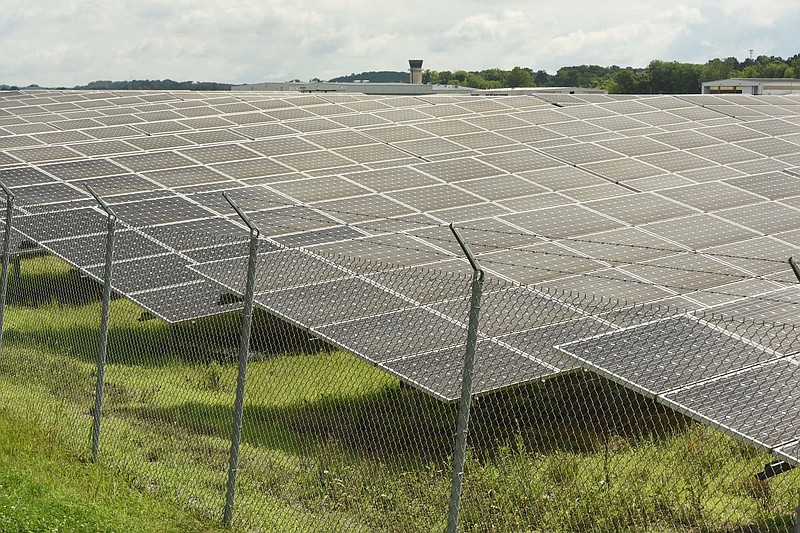The Tennessee Valley Authority could achieve completely clean and green energy generation by 2030 by making major expansions of solar, wind and energy storage and by encouraging its customers to do more with both energy efficiency and their own solar and wind generation, according to a new environmental study of Southern utilities.
The Southern Alliance for Clean Energy says TVA could be completely carbon free by 2030, but to do so will require immediate action and TVA officials caution that may boost energy prices and leave TVA more vulnerable to power outages.
"TVA has a long history of being a critical part of America's infrastructure and we're calling on TVA again to lead in this battle against climate change and to get to zero carbon by 2030," said Stephen Smith, executive director the Knoxville-based Southern Alliance for Clean Energy.
President Biden has called upon America's electricity utilities to get to net zero emissions of greenhouse gases by 2035 with a new Clean Energy Standard for the industry. Smith said as a federal corporation created to be a model for the industry, TVA should get to zero carbon emissions within the next decade.
"We believe it needs a national mission like this to justify its existence," he said, noting that TVA was created in 1933 to help boost an impoverished Appalachia by harnessing the power of the Tennessee River.
TVA built a network of 29 power generating dams early in its history to help electrify the South and provide low-cost power for the region to develop. As power use grew in the Valley, hydroelectric dams were supplemented with coal, nuclear and natural gas plants and today TVA dams supply only about 10% of the electricity generated by TVA.
In a 24-page study released this week on how Southern utilities could become carbon free, the Southern Alliance for Clean Energy suggests TVA turn to the sun and more wind generation for nearly half of its power and to encourage more distributed energy generation from consumers with their own solar panels. TVA also could encourage more energy efficiency in homes and offices and continue to promote the electrification of the transportation system to limit carbon emissions from the burning of gasoline in cars and trucks.
"Action on clean energy resources must begin immediately and aggressively to get to zero carbon," said Maggie Shober, director of Utility Reform for the Southern Alliance for Clean Energy. "Because TVA is strategically located, has a high amount of traditional and pumped hydro resources that can help it integrate high levels of wind and solar, and is directly controlled by the federal government, we crafted a pathway for TVA to get to 100% clean electricity five years earlier than the rest of the sector."
TVA has already reduced its carbon emissions by 63% from the peak reached in 2005 and has already shut down more than half of the 59 coal-fired power plants it once operated in the region. TVA directors last month approved a planning guide to get to a 75% reduction in carbon emissions by 2030 and to achieve an 80% reduction from the 2005 levels by 2035 by adding more solar generation across TVA's 7-state region. By 2035, TVA is planning to shut down all of its coal power plants.
TVA President Jeff Lyash said the utility has set an aspirational goal to be carbon free by 2050 but to achieve that milestone will likely require new nuclear generation and new technologies for carbon capture from natural gas plants or other new types of renewable energy and storage capability. Lyash said electric vehicles will keep power demand up in the Valley and natural gas plants are needed as an interim source of power when the sun doesn't shine and the wind doesn't blow.
TVA projects it will continue to reduce its carbon emissions while keeping its base power rates unchanged over the next decade.
Smith said the world doesn't have the luxury of waiting that long to cut out the emissions of greenhouse gases linked to global warming.
"Throughout the world and across our country, we're already seeing unprecedented climatic challenges," Smith said, citing wildfires and droughts in the western U.S. states and the threats of flooding and storm damages in other states from climate change. "No one is immune to climate change so we need to address this issue and do so as quickly as possible."
Smith said the cost from climate change due to more storms, flooding, wildfires and rising sea levels could be immense and make carbon-free energy a wise business choice. Energy efficiency measures also could help hold down utility bills even if electricity rates go up.
Shober said her analysis of a carbon-free future for TVA was not based on the lowest cost alternative followed by TVA under its charter mandate to deliver electricity at the lowest feasible costs.
TVA officials said the utility was not consulted or involved in the power forecasts and projections made in the new study and relying too much on new solar and wind generation might lead to power outages or reliability problems as happened in Texas this winter when wind and solar power failed to deliver enough energy and millions of electricity users were left in the dark.
"We have seen what has happened this year to electric grids that depend too heavily on renewable energy," TVA spokesman Scott Fiedler said. "The proposal (from the Southern Alliance for Clean Energy) clearly states it does not take into account cost and reliability which may negatively affect low-income residents and the region's ability to attract jobs and investment to revitalize urban and rural communities."
Despite claims by Texas Gov. Greg Abbott and others that failing windmills and solar generation created the blackouts in February, the Electric Reliability Council of Texas said failures in natural gas, coal and nuclear energy systems were largely responsible for most of the power outages last winter when temperatures plummetted in the Southwest.
Contact Dave Flessner at dflessner@timesfreepress.com or at 423-757-6340

